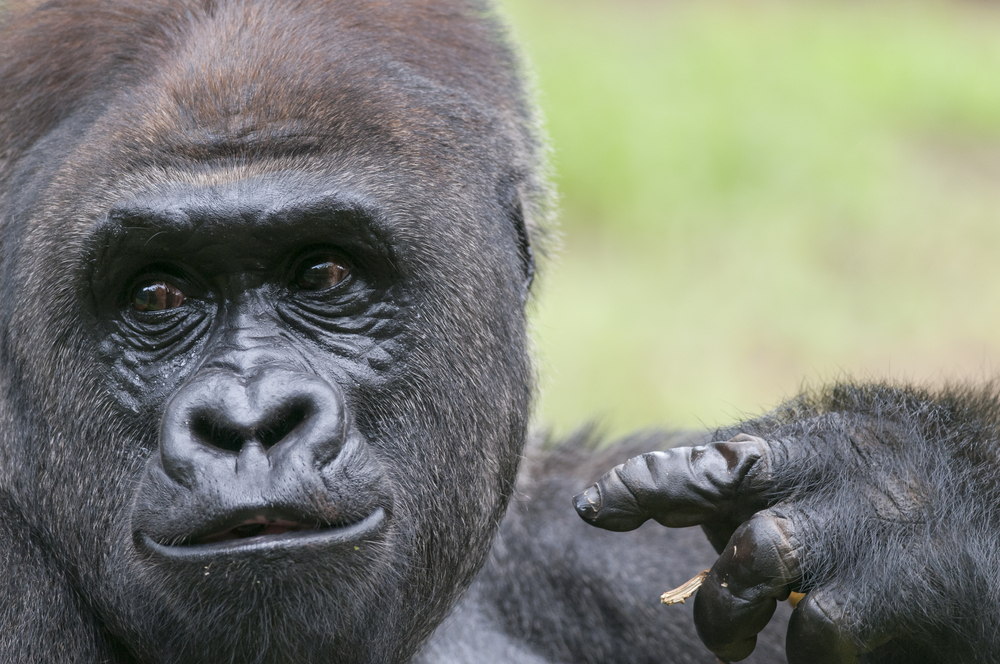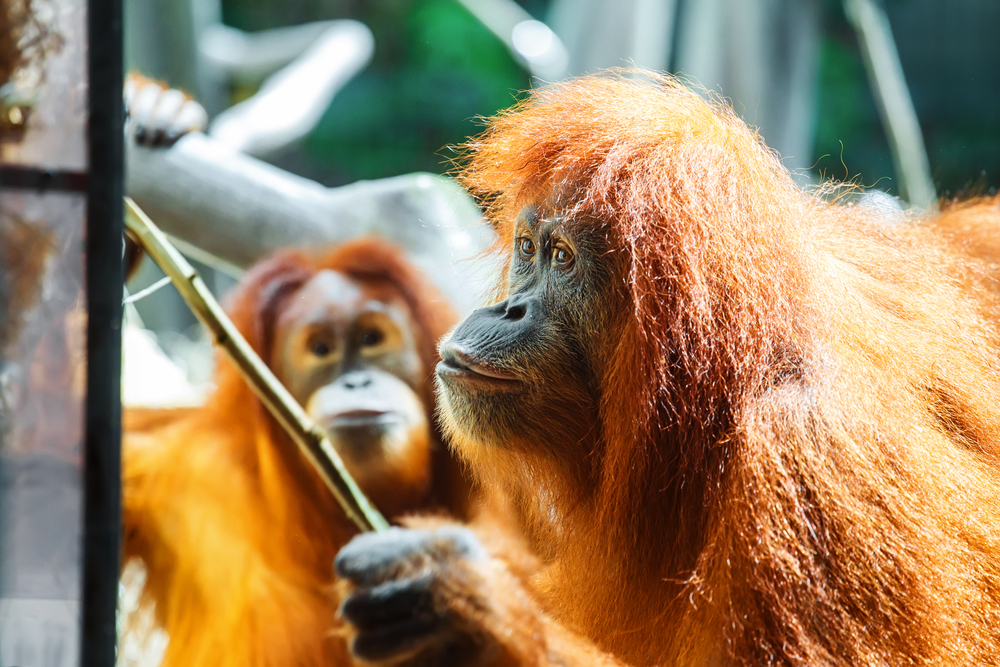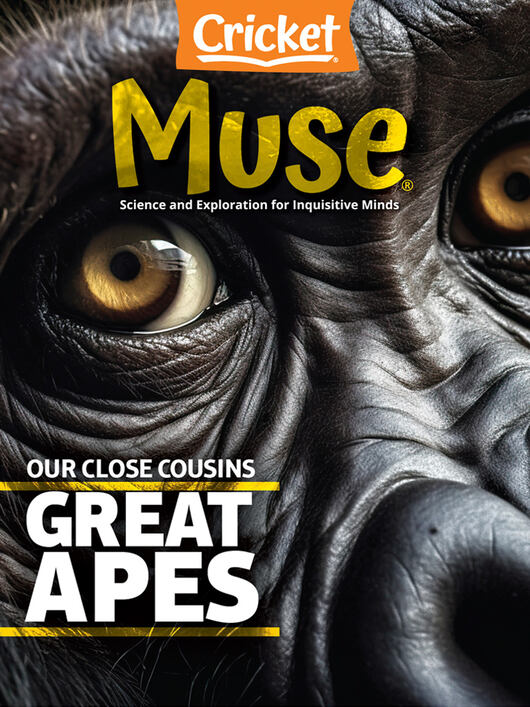Happy APE-ril! During this month, we celebrate both Earth Day and Dr. Jane Goodall’s 90th birthday! In honor of these momentous occasions, we’re looking at some of the most fascinating facts about great apes. The April issue of MUSE Magazine is all about our closest primate relatives, and we’re here to share some of our favorite tidbits of knowledge! From their outstanding intelligence to incredible physical adaptations, there’s plenty to admire about apes.
Some apes are more closely related to us than to each other
It’s easy to think of apes as one ‘group’ and humans as another. After all, check out your average zoo. Chimpanzees, gorillas, and orangutans live on exhibit while humans work as the zookeepers. But according to cladistics, things are a little more complicated than that. ‘Cladistics’ is a modern, statistics-based form of classification that sorts related species onto diagrams called ‘cladograms.’ The closest relatives will share an evolutionary branch on the cladogram. If you look at the great apes’ family tree, you’ll find an interesting surprise: humans are more closely related to chimpanzees and bonobos than either of those species is to gorillas or orangutans! We share nearly 99% of our DNA with chimpanzees and bonobos. (We share around 98.3% with gorillas and about 97% with orangutans.)
The tails– or lack thereof– tell a tale.
What makes a primate? Among other things, the ability to hang by our arms, which monkeys, apes, and humans can all do. They’re called monkey bars for a reason! But then how can you tell the difference between a monkey and an ape? For one, apes don’t have tails, and that includes us. Humans and other apes are all descended from primate ancestors that lived in trees and used tails to help them climb. As ape species evolved, tails faded away, and some scientists think they’ve even found the mutations responsible. But there’s still one sign remaining of the tails that our ancestors used to have. Unused parts left over from earlier phases of evolution are called ‘vestiges.‘ That includes our tailbones!

Apes can use tools, too!
There’s a stereotype that using simple tools– like fashioning hand axes– was what separated early humans from animals. But you may be surprised to learn that some of our ape relatives use tools, too. Chimpanzees’ use of tools has been especially well-documented, partially courtesy of Jane Goodall. She observed chimps stripping twigs of their leaves and using them to poke inside a termite mound in search of tasty insects. That’s practically a serving utensil! Apes have also fashioned ‘sponges’ out of moss, ‘umbrellas’ out of branches, ‘spears’ out of sharpened sticks, and ‘nutcrackers’ out of rocks. Apes aren’t the only tool users in the animal kingdom, either. Plenty of other species, like crows and elephants, fashion simple tools, too!
Chimps have their own form of math and can sometimes solve problems that humans can’t!
Okay, so apes can create and use tools. But certainly they can’t understand numbers… right? Believe it or not, apes have a well-documented sense of numbers and values– and not just apes. Monkeys have been successfully trained to identify the greater of two sets of dots. Even birds and bees show signs of number sense. After all, animals need to figure out survival strategies all the time, and that requires understanding concepts like more and fewer.
But chimpanzees have shown a remarkable ability to pass a math test that most humans fail. Scientists flash a series of random numbers on the screen of a computer. The test-taker must then repeat the sequence in the correct order. Amazingly, while most humans can only remember a few of the numbers, chimps often pass the test with staggering accuracy. Researchers think that this photographic memory is an evolutionary survival skill. Thanks to humans’ of language and collaboration, we don’t need photographic memories anymore for survival. They faded away just like our tails.
Humans aren’t the only primates who use medication
The wild is all about survival of the fittest, right? That means that a sick or injured animal is left to die, while we civilized humans treat our ailing family members. We hate to burst your bubble, but once again, the apes are right there with us. In one touching example, PhD student Alessandra Mascaro observed a mother chimpanzee named Suzee making a paste out of a chewed-up insect and applying it to a cut on her son’s foot. Since then, researchers have noticed at least 19 similar instances– all involving insects. Perhaps they’ve discovered a medicine that we don’t know about yet!
Have you ever wondered if orangutans’ arms get sore from brachiating (swinging around) all day? We have, too, and now we might have definitive proof that they do. After a long day spent in the treetops, orangutans have been spotted making a kind of soothing balm out of chewed up or mashed up leaves and applying it to their arms. These leaves, Dracaena cantleyi, have anti-inflammatory properties and really can make sore muscles feel better!

Apes may or may not use language– but they sure can communicate!
Do apes have language? It’s a complicated question. They certainly can’t produce physical speech the way that most people can. That’s largely to do with the neural connections between their brains and larynxes. Humans have lots, which allows us to talk easily. Apes? Not so much. So how do they communicate with one another in the wild? They use body language, facial expressions, and vocalizations, not words. Gorillas, for instance, make around 20 to 25 different sounds. But many researchers have conducted experiments to teach apes how to communicate with people using a modified form of American sign language.
It turns out apes are very good at learning and mimicking signs. Koko the gorilla understood around 1,000 signs and created her own unique ‘words’ combining them. But apes haven’t shown a clear grasp of grammar and syntax. They can use words to communicate, but is it really ‘language’ without the rules of a language? Similarly, Kanzi the bonobo has been trained to tap ‘pictograms’ attached to a computer that vocalizes his commands. He knows around 3,000 words! (Kanzi is very tech savvy for a bonobo. He’s even learned to play a simplified version of Minecraft.) But even Kanzi doesn’t seem to be able to take the leap from ‘using and identifying words’ to combining them together into formal language. Still, it’s clear that apes and humans are able to communicate with one another.
Great ape species are endangered, and there are ways we can help
Sadly, there is one major thing that separates humans from other ape species: all other great apes are threatened due to habitat loss, poaching, and other human-created causes. The IUCN Red List considers chimpanzees and bonobos to be endangered. Mountain gorillas are also endangered, while eastern and western lowland gorillas are critically endangered. In possibly the most dire circumstance of any ape, all three species of orangutan are critically endangered. One major threat against orangutans is the cultivation of palm oil.
Palm oil is popular and versatile, appearing in everything from chocolate to shampoo. Peek at the labels around your home and you might be surprised to find how often palm oil makes an appearance. To create more palm oil plantations, humans destroy orangutans’ tropical rainforest habitat, causing orangutan numbers to decline by thousands every year.
Scientists are doing what they can to combat this loss and protect orangutans. But how to observe elusive creatures that live in such dense environments? With drones! Using drone-mounted cameras, researchers track and count orangutans and their nests, monitoring wild populations in areas most threatened by logging or fires.
How can you help our furry cousins? One way is to shop for products that either don’t contain palm oil or feature an RSPO label indicating sustainably sourced, orangutan-friendly palm oil. You can write to the companies that create your favorite products and ask them to choose sustainable palm oil.
What surprises you most about your ape cousins? Do you feel closer to them now? We’d love to hear more from you!





